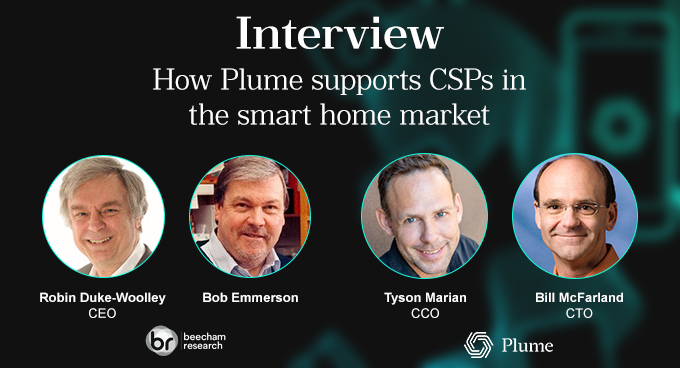Robin Duke-Woolley, CEO and Bob Emmerson of Beecham Research interview Tyson Marian, CCO and Bill McFarland, CTO of Plume.
Robin: Tyson, Plume has been in the smart home market for more than six years. At the start of 2020 you had 50 communication service providers (CSPs), now you have close to 200. What happened?
Tyson: What happened to stimulate this growth is a mix of the technology being refreshed and a dramatic shift in customer expectations in recent years. The move in terms of technology generation is something that happens every seven to ten years or so, and that is reflected in Plume’s smart home solution. Those customer expectations are predicated on services that give customers what they want now, which encompasses the ability to go online, find what they want, buy it and get it delivered to their home. That is today’s service model and CSPs who can’t provide that can’t be competitive. Today’s technology model is software-based and cloud-centric and dependent on delivery over broadband networks and this is in contrast to legacy solutions that are hardware-centric and can’t deliver the requisite service functionality.
Robin: What impact has Covid had on the market?
Tyson: Covid has accelerated the trend towards that service-centric, “I want it now” model. Our solution has been deployed in more than 24 million homes and in 2020 all- round usage of our services went up by around 200%. Within that, utilisation of desktop devices rose by 125% as a result of more people working from home. Right now, the average smart home has 17 connected devices and we can expect to see more in future so broadband connectivity is needed to accommodate the increased traffic and consumers’ expectations are for rates of 100Mbps or even 200 to 250Mbps. However, I don’t think smart home deployments should turn into a numbers game. Certainly, high data rates are needed, but the key performance parameter is the ability to optimise the flow of traffic to and from the different devices. It is this that will determine end users’ experiences and it hinges upon the ability to optimise billions of individual flows of data, something that can only be managed in the cloud.
Users of different connected devices employ different business models that are tied to the device and many more devices will be added in the near- and medium-term but with legacy, hardware-centric solutions, new devices have been and will continue to be a problem. Installing hardware was traditionally a challenge, so users made lots of service calls, trucks rolled and very often devices were returned. We have addressed the device issue with a Device Provision Protocol technology that asks the consumer to authenticate usage of new devices on their network and when granted installation is automatic and instantaneous.
Register now to read the full interview in the report







